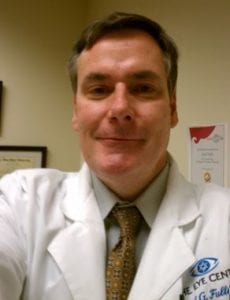 Dr. Neal Bailey was born in Gardenville, New York, on November 6, 1917 and spent his summers on the banks of the Shiawasee River at a rustic family cabin north of Detroit. After graduating from high school, he completed chiropractic school in San Antonio, Texas.
Dr. Neal Bailey was born in Gardenville, New York, on November 6, 1917 and spent his summers on the banks of the Shiawasee River at a rustic family cabin north of Detroit. After graduating from high school, he completed chiropractic school in San Antonio, Texas.
During World War II, both he and his beloved wife of 57 years, Florence, worked seven days a week at the Ford Motor Company in Detroit, Flo in the payroll department, and Neal ran a steel furnace producing high-grade armor plating for tanks. They moved to Columbus in 1944 when the first of their two daughters was born; and Dr. Bailey graduated from The Ohio State University School of Optometry in 1947 with a BS in optometry (summa cum laude) and then again in 1954 with a PhD in physiological optics under the direction of Dr. Glenn A. Fry. He and his family then moved to Bloomington, Indiana, where he created the first contact lens teaching facility at the Indiana University School of Optometry.
In 1958, the Baileys returned to Columbus and opened a private practice of optometry in a three-story home on Ohio State’s Fraternity Row. Dr. Bailey, with Flo’s help, maintained a successful practice in the campus area for many years. Dr. Bailey served the college as clinical associate professor, 1990 convocation speaker, and major benefactor to the college, its students, and faculty. In his convocation address on June 7, 1990, he gave seven sage recommendations to the class, including, “Be sure to find a good lawyer,” “Honor thy teacher—for a really good teacher is hard to find,” and “Don’t confuse professionalism with costly furnishings and spacious offices. Professionalism is an attitude that needs constant nurturing.” Dr. Bailey was the editor and founder of Contact Lens Forum in 1976 and later the editor and founder of the Contact Lens Spectrum in 1986, two leading contact lens journals that have been combined.
Dr. Bailey authored 120 articles and chapters on contact lenses and practice management and was one of the first clinical investigators of soft contact lenses in the United States. He was the recipient of numerous prestigious awards, including Distinguished Practitioner in the National Academies of Practice (1984), the Max Schapero Award from the American Academy of Optometry (1986), the Leonardo da Vinci Award from National Eye Research (1988), and the Dr. Josef Dallos Award from the Contact Lens Manufacturers Association (1988). In 1989, he was honored as the “Contact Lens Person of the Year” by the American Optometric Association’s Contact Lens Section. In 1992, he received the Kevin Tuohy Award from the Contact Lens Society of America. On May 26, 1995, the college honored him again by striking a new medal presented to—and named for—him: the Neal J. Bailey Medal for Development.
Dr. Bailey was affectionately called the “Contact Lens Curmudgeon” by his friends for his insistence upon the highest principles of professionalism. According to Dr. Joe Barr (OD’77, MS’79), “Dr. Bailey was precise, organized and uncompromising as an optometrist and as a businessperson. Yet he was one of the most comfortable persons to be with.”
He was famous for joking that the perfect contact lens design was a “Holecon” lens: one with a 9-mm overall diameter and a 10-mm fenestration. He once served on a panel at an American Academy of Optometry annual meeting with Dr. Robert Mandell from the University of California, Berkeley School of Optometry, who was also a prominent clinician, educator, researcher, and author in the contact lens field at that time. When someone in the audience asked Dr. Mandell why he wore glasses instead of contact lenses, he replied: “My wife thinks I’m sexier in glasses.” When the same question was posed to Dr. Bailey, he said: “Because Bob Mandell’s wife thinks I’m sexier in glasses too!” Such was the wit of one of Ohio State’s most prominent optometric alumni.
Dr. Bailey sold his private optometry practice at 32 East 15th Avenue in 1981 to Dr. LaMar Zigler (OD/MS ‘81), and completely retired from practice in 1983. He and Flo then moved to Worthington and later to Laredo, Texas. In his retirement years, he traveled the United States to ride his bicycle on paths created by his favorite non-optometric charity, “Rails-To-Trails Conservancy.” He passed away in December 2006. At its meeting on March 2, 2007, The Ohio State University Board of Trustees approved a Resolution in Memoriam for him.










